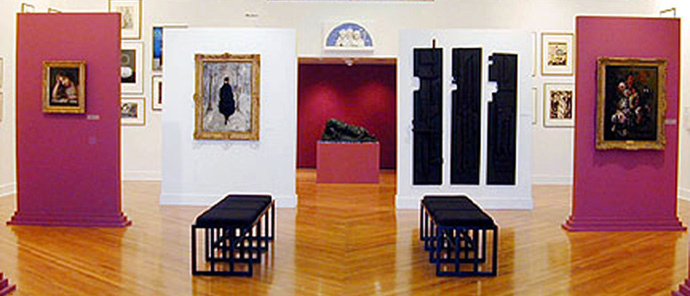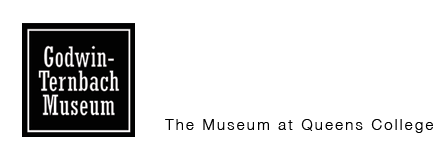 In 1957 the Queens College Art Collection began as a teaching collection for students to handle and study works of art and “as a general cultural resource for the wider community of Queens and New York City.” At that date it consisted of approximately 350 objects and began to organize exhibitions with loans from important collections at the Brooklyn, Metropolitan, Harvard and University of Pennsylvania Art Museums to the Pierpont Morgan Library, Walters Art Gallery, and others, led by now legendary art historians like Edith Porada and Frances Godwin.
In 1957 the Queens College Art Collection began as a teaching collection for students to handle and study works of art and “as a general cultural resource for the wider community of Queens and New York City.” At that date it consisted of approximately 350 objects and began to organize exhibitions with loans from important collections at the Brooklyn, Metropolitan, Harvard and University of Pennsylvania Art Museums to the Pierpont Morgan Library, Walters Art Gallery, and others, led by now legendary art historians like Edith Porada and Frances Godwin.
This tradition of organizing significant exhibitions continues into the present and the collection has grown ten-fold over the years. The Godwin-Ternbach Museum fills a cultural void by providing a collection, exhibitions, and educational programs that highlight archeological and fine art objects that span the centuries—something no other institution in Queens can offer.
The Museum was founded in 1981, but the Queens College Art Collection reaches as far back as the 1930s, with the founding of the College in 1937 during the Great Depression. Among its most important donations was that of Audrey McMahon, co-founder of the WPA Federal Art Project and New York Regional Director. McMahon donated her personal collection of prints from the early Renaissance to modern times and it forms the core of the Museum’s outstanding print collection, enriched by subsequent donations from alumni and friends.
 The Museum has a distinguished history due to its founders. Frances Godwin and Joseph Ternbach. Frances Godwin was an art history professor at Queens College whose academic focus was early and Medieval Christian art. Beloved by her students, she was the one to spearhead use of the collection as a teaching tool and to create hands on experiences for Queens College students to view, touch, and learn from the wonderful range of objects in the collection. Joseph Ternbach was a noted art restorer who settled in Queens after escape from Nazi persecution in Vienna, attracted eminent donors like Norbert Schimmel, Jack and Belle Linsky, and Charles B. Rogers, who were patrons of the Metropolitan Museum, National Gallery of Art, and Smithsonian Institution; Leon Pomerance, Ernest Erickson and Syril and Walter Frank of the Archeological Institute of America; Hans Arnhold, founder of the American Academy in Berlin; and Elie Borowski, founder of the Bible Lands Museum in Jerusalem, to name only a few.
The Museum has a distinguished history due to its founders. Frances Godwin and Joseph Ternbach. Frances Godwin was an art history professor at Queens College whose academic focus was early and Medieval Christian art. Beloved by her students, she was the one to spearhead use of the collection as a teaching tool and to create hands on experiences for Queens College students to view, touch, and learn from the wonderful range of objects in the collection. Joseph Ternbach was a noted art restorer who settled in Queens after escape from Nazi persecution in Vienna, attracted eminent donors like Norbert Schimmel, Jack and Belle Linsky, and Charles B. Rogers, who were patrons of the Metropolitan Museum, National Gallery of Art, and Smithsonian Institution; Leon Pomerance, Ernest Erickson and Syril and Walter Frank of the Archeological Institute of America; Hans Arnhold, founder of the American Academy in Berlin; and Elie Borowski, founder of the Bible Lands Museum in Jerusalem, to name only a few.
Valuable donations of artworks have come from many quarters. J.B. Neumann, an eminent art dealer, critic, author, publisher, and advisor to Alfred H. Barr, Jr. Director of The Museum of Modern Art, gave the museum many fine artworks. An emigré from Germany in 1923, Neumann opened the New Art Circle gallery, exhibiting artists Wassily Kandinsky, Max Beckmann, Paul Klee, and Georges Rouault, among others.
 In 1999, the New Mexico-based Lannan Foundation gave the Museum a large group of Spanish and Latin American works by notable artists from Brazil, Chile, Cuba, Guatemala, Mexico, and many regions of Spain, highlighted in our 2004 Recent Acquisitions exhibition.
In 1999, the New Mexico-based Lannan Foundation gave the Museum a large group of Spanish and Latin American works by notable artists from Brazil, Chile, Cuba, Guatemala, Mexico, and many regions of Spain, highlighted in our 2004 Recent Acquisitions exhibition.
Other donations, largely from alumni and their associates often have equally compelling histories, too numerous to discuss in this brief history. But their gifts are being reconsidered and brought back into the light, along with new discoveries, as we undertake a new generation of research and exhibition.
Thanks to the generosity of so many donors of artworks and funds, the Godwin-Ternbach Museum has become an outstanding small institution, with a rich past and substantial collections to build upon.
